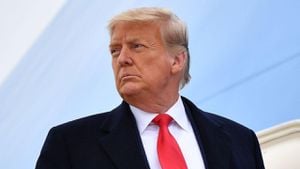Western nations are closely observing the shifting sands of international alliances, focusing especially on NATO's increasing collaboration with the Indo-Pacific region. The security alliance's response is key as it navigates complex challenges stemming from rising tensions on its eastern borders, particularly those involving Russia and China.
Recent joint naval drills between Russian and Chinese forces have underscored the growing military cooperation between the two nations, prompting strategic reevaluations among NATO members. According to observers, this could distract the United States from its European commitments and potentially weaken the NATO alliance. Experts suggest Russia seeks to focus American military attention on the Indo-Pacific, thereby reducing U.S. visibility and support for European allies.
With Moscow conducting large-scale military exercises, including the recent joint ventures with China aimed at showcasing their collective strength, many experts view these maneuvers as deliberate attempts to intimidate both regional and Western adversaries. Notably, among the participants of these exercises were no fewer than fifteen countries, with the primary partnership remaining between Russia and China.
"Russia's strategy appears twofold: to alleviate Western pressure on its borders and to project power through joint military actions with China," explained Ying-Yu Lin, a military analyst. This aligns with observations of both nations seeking to leverage their military cohesion to send complex messages to NATO and individual countries, especially those who may oppose their ambitions.
China’s growing footprint near NATO’s periphery seems partly motivated by NATO's plans to increase its partnerships with countries such as Japan, South Korea, Australia, and New Zealand—collectively known as the IP4. NATO has indicated the significance of developments within the Indo-Pacific as directly impacting Euro-Atlantic security. This collaborative effort aims to bolster mutual awareness and strengthen their defensive postures against increasingly assertive powers.
Former NATO Secretary General Jens Stoltenberg has voiced strong criticism of China’s increasing military assistance to Russia, labeling it as instrumental to the Kremlin's military actions. He asserted, "China is complicit as it continues to provide vast support to Russia's military industry, equipping it with the necessary resources for its defense.” This rhetoric indicates NATO's intention to draw clear lines and hold accountable those perceived as enablers of aggression.
Reactions from various countries highlight concerns about losing regional balance and provoke accusations against NATO of overstepping its bounds. A spokesman for the Chinese Foreign Ministry remarked on NATO's growing ambitions, labeling them as breaches of boundaries and provocation to confrontation. Such remarks illuminate the tensions shaping the current geopolitical climate.
Despite the rhetoric, analysts indicate limited enthusiasm for NATO's expansion beyond its established territories, particularly concerning actual security guarantees for Eastern partners. The force behind NATO’s strategic choice seems to hinge on the alliance’s desire not to escalate tensions with China and Russia unduly. Sari Arho Havren, from the Royal United Services Institute, elaborated on this caution, urging NATO to maintain the status quo and avoid perceptible provocations against China.
Geopolitical strategists acknowledge NATO's interest lies primarily within its traditional areas of responsibility and its immediate European regions, hinting at continued selectivity when defining its comprehensive security framework. Consequently, NATO's current engagements lean toward collaboration on global issues, such as cybersecurity and counterterrorism, rather than explicit military expansion.
One significant binding factor for NATO's Eastern European partners is their existing commitment to Article 5 of the NATO treaty, which mandates mutual defense. Yet, experts unanimously suggest the alliance desires to err on the side of caution, performing diplomatic gymnastics to manage relationships with both Asia-influenced partners and avoid aggravation of tensions with Beijing and Moscow.
Developments remain fast-paced and increasingly interconnected, with NATO facing the challenge of ```balancing`` existing commitments, bolstering its defense postures, and assessing the geopolitical ramifications of its collaborations across regions.
With the growing diplomatic exchange and military collaboration between NATO and the IP4, cooperative initiatives are being fleshed out, emphasizing intelligence sharing, especially as it pertains to cybersecurity drills and disinformation combat strategies imperative for maintaining regional stability. A new focus includes dedicated communication channels for sensitive information exchange aligned with their international defense objectives.
One notable aspect of NATO’s shifting strategy involves the concern stemming from Taiwan, not only as a point of regional tension with China but also as the heart of the semiconductor supply chain, feeding technology across various industries, from automotive to telecommunications. The protection of Taiwan has emerged as a focal point for NATO’s assessments of Indo-Pacific security.
Looking at its member states’ capabilities, discussions continue over NATO's overall capacity to extend its commitments to the region without overstretching. Arho Havren noted the resource limitations European allies face, impacting their ability to engage comprehensively with Indo-Pacific commitments. Many of these countries do not reach the 2% national GDP guideline on defense expenditure, which NATO posits as ideal for member states.
The complex interplay between Western nations and Indo-Pacific allies reflects contrasting approaches and commitment levels, with reservations rife among European nations. Instances such as France’s recent veto against establishing NATO liaison offices signal the hesitancy within the alliance to stir up more significant geopolitical challenges.
NATO's response to these multifaceted challenges is still forming, but members are increasingly aware of the shifting dynamics and the pressing need to re-evaluate traditional security paradigms. With Russia and China asserting their military capabilities vocally and visibly, the paths NATO pursues going forward could reshape trans-Pacific alliances as nations grapple with new forms of threats and collaboration.
Understanding NATO's strategic shifts amid these challenges is fundamental for assessing the broader security architecture, all influenced by the ever-evolving geopolitical climate stemming from the East.



